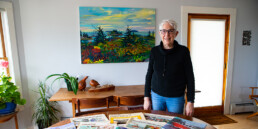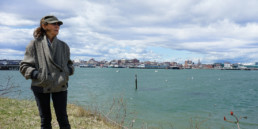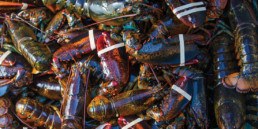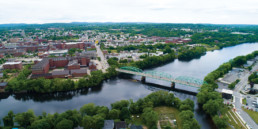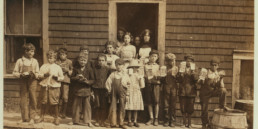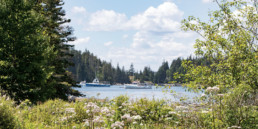Aquaculture’s Next Wave
Mussels, oysters, and kelp emerging along Maine’s southern coast.
By Nancy Griffin
Casco Bay, dotted with hundreds of islands and stretching over 25 miles from Cape Elizabeth to Cape Small, is seeing an upswing in what could prove to be a new economic engine for the area—shellfish and seaweed farming.
“It’s a really interesting area for aquaculture in the state,” said Sarah Redmond, marine extension associate with Maine Sea Grant at the Center for Cooperative Aquaculture Research in Franklin.
“There’s a wide diversity of companies growing different things, and it’s next to the largest city in Maine. It’s the busiest area in water-related business—shipping, recreational boating, fishing, ferries, tankers—and with year-round island communities,” she said.
“Casco Bay, especially northern Casco Bay, has lots of diversity in temperature and salinity and a lot of variety in habitat, and these are the kind of locations people have been occupying in recent years,” Redmond added.
Location is all-important for Maine marine farmers, said Redmond, because the largest expense can be transportation of products to market.
That’s one of several reasons Peter Stocks, owner of Calendar Island Mussel Company, is growing mussels off Chebeague Island in Casco Bay. “We can harvest from a clean bay, drive product to Boston in a few hours, New York in twelve hours, and to Chicago in twenty-four hours.”
Portland is an accommodating home port, he said, with the fish exchange, cold storage, and trucks to Boston every day—all key amenities. “We can buy tons of ice, and if we need a mechanic or vessel support services, it’s there,” he said. “That doesn’t exist in other parts of the state,” he added.
Because of the opportunity aquaculture provides for diversifying and stabilizing income for coastal residents, whether they’ve been involved in marine businesses or not, the Island Institute, publisher of Island Journal, has launched an aquaculture business development initiative. The project provides business support and marine resources technical assistance to 23 participants, 16 of whom are in the process of submitting lease applications to the Department of Marine Resources (DMR) or have already gotten approval to start farms. The goal is to support those working toward establishing kelp, mussel, or oyster aquaculture businesses within the next two years.
Building Bigger Mussels
Maine mussel growers are hoping to put a serious dent in the market share of Prince Edward Island growers, who currently dominate. “They produce thirty-five million to forty million pounds a year. We see their trucks crossing Maine all the time,” said Stocks, who also has a farm in Blue Hill.
But Maine mussels are prized for size.
“We command a twenty- to twenty-five-percent price premium over PEI mussels because of quality,” said Stocks. “And because we’re two to three days closer to the major markets, ours are fresher, and they’re between fifty to one hundred percent bigger.”
Calendar Island Mussels sells primarily out of state, though two Portland restaurants feature the product. Stocks plans to launch retail sales via the Internet.
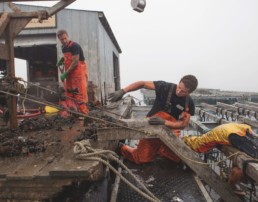
“We can harvest from a clean bay, drive product to Boston in a few hours, New York in 12 hours…”
— Peter Stocks
Part of the appeal of being in the mussel aquaculture business is that once they begin growing, there is little for the owner to do. But rope-grown mussels constitute a pricier start-up business than, for example, oysters, explained Dana Morse, marine extension agent with Maine Sea Grant, based at the Darling Marine Center in Walpole.
“The equipment and capital involved are significant,” said Morse. “You might sell fifty thousand oysters, compared to the hundreds of thousands of mussels you would need to sell [to cover costs].”
While mussels don’t command as high a price as oysters, they do take up less space than oysters, and can be harvested nearly year-round.
“There’s some seasonality,” said Stocks. “We have to balance the needs of the farm-to-table movement with that of the natural cycles of the product, which is live, not frozen.” Generally, he harvests from August to June. Red tide, a naturally occurring ocean algae bloom that comes in the warm months, often shuts down harvest in late June and for most of July.
The summer months are when maintenance is done on the water-based equipment, and when “seed” is collected.
“We don’t purchase seed,” Stocks explained. “We collect it on ropes,” known in the business as “fuzzy ropes,” in areas where mussel beds are close to shore. “Shellfish farms create a lot of larvae because they naturally exist in the ecosystem. One female mussel can produce one thousand to one million larvae.”
Matt Moretti, 31, formed Wild Ocean Aquaculture to purchase Bangs Island Mussels with his father in 2010. He developed an interest in marine farming in graduate school for marine biology, “but I didn’t think I’d do it,” he said. When he decided to try it, he began his career working on an oyster farm in the Damariscotta River.
“Finfish you have to feed; mussels are filter feeders, [meaning] they remove algae and other inorganic nutrients from the water,” said Moretti, “so they improve water quality.” He expects to harvest 200,000 mussels a year on his farm, which covers 3.6 acres (though only about 10 percent of the surface area is used). The state issues leases for aquaculture sites after holding public hearings.
The mussels are grown on ropes that hang 35 feet into the water from rafts, with around 400 lines per raft. Moretti does most of the work on a 40-foot barge, using net reels as lift lines. He lives on his boat—an old trawler—and brings the mussels back to a Portland wharf for processing. “I’m right here, all the time.”
But Moretti’s not sticking strictly to mussels. He’s trying “integrated, multi-trophic aquaculture,” defined as providing the by-products of one aquatic species as inputs—fertilizers, food—for another. In other words, “We’re growing two species on the same site, and they benefit one another.”
His second product is kelp, a kind of seaweed. “Both extract nutrients from the water. Both help improve water quality. We’re able to produce a large amount of biomass with a small footprint,” he explained.
Oysters on the Full Shell
Bob Earnest and David Whiston started Chebeague Island Oyster Company in 2013.
“Our original goal was centered on creating jobs, local and sustainable,” Earnest recalled. “Our second goal is to make sure our activities, site selection and all, didn’t interfere with lobstering.” Both are board members of the Chebeague Island Community Association, and care about the town.
The first year, these “two old guys from away,” as Earnest describes them, bought 50,000 spat (baby oysters). “The goal was to get the farm started, get young people interested,” he said. The second year, they ordered another 50,000 spat, built up their supply of cages, built an upweller (a pump device that moves water upward to improve circulation), and acquired a couple of old boats.
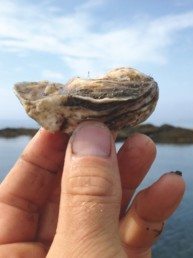
A Basket Island oyster
“Year three, we ordered 250,000 spat,” said Earnest. “We wanted to start out slow and learn. We intend to buy 500,000 next year, and level off there. In Maine, it’s three to five years from spat to harvest.” A young lobsterman has joined the business, and Earnest worries that it’s hard on him because he works for “the other.” Lobstering is the island’s biggest employer, and “we made sure to stay out of their way.”
Last summer, they offered limited sales on the island to friends and family. When production increases, they still want to be sure the island is supplied first, before the other markets they hope to set up.
Mark Green, a Peaks Island resident, operates Peaks Island Shellfish and Basket Island Oyster Company. He’s been raising oysters for three years and is nearing the harvest. “It’s an absolute minimum of two years to sell an oyster. It’s a long time to invest money and not get a return,” he noted.
Green estimates the company has close to a million one-inch oysters, and in a year, after a good growing season, “We will have a lot of oysters.”
He jokes that “You’re not really an oyster farmer until you kill your first million oysters.” When he has a steady supply, he plans to sell in Boston. Now he sells to Portland restaurants through a dealer. His oysters grow in suspended cages just off the seafloor, and while tiny, are also in bags.
“Maine is really well-positioned, arguably the best in the country,” said Green, who has a PhD in oceanography and is still a professor at Saint Joseph’s College in Standish. “We can produce a lot, we have cold water, salt water, and the water is full of food.”
His advice for those who want to farm shellfish: Have realistic expectations, and take longer than you anticipate.
Jon Rogers fishes for lobster out of Bailey’s Island, but also operates Dogs Head Oysters, farming on the northern tip of Orrs Island, as of July 2015. “I signed up for a ten-week course at the Darling Marine Center. After the third class I went home and filled out an application for a four-hundred-square-foot lease,” he said.
“I took a chance. Before I got the lease, I ordered seed from an outfit in Bremen. In early July, the seed was ready and I had approval for the leases,” Rogers said. “If it works out, I’ll be done lobstering.”
Kelp on the Way
John Lewis has worked at DMR for 18 years, and in 2015 was made head of its new aquaculture division. When Paul Dobbins told Lewis in 2009 that he planned to farm seaweed, “I said publicly that he would fail,” Lewis recalled. “Now I say publicly that I was one hundred percent wrong.”
Dobbins started Ocean Approved Seaweed because he saw an opportunity in a burgeoning industry with high demand. He grows four kinds of seaweed: sugar kelp, horsetail, winged kelp, and “skinny sugar kelp,” which “grows like a weed,” Dobbins quipped. Growing seaweed is not the biggest challenge. It’s a relatively low-tech, low-cost kind of aquaculture with a quick grow-out period. The bigger trick is creating quality products with market value.
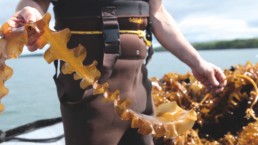
Paul Dobbins of Ocean Approved holds up a strand of sugar kelp.
“We develop products. Most aquaculturists grow and then market. First we developed products and created markets—then we grew.”
The company received grants from the US Department of Commerce and the Maine Technology Institute to bring seaweed to a commercial scale. Dobbins chose to open-source all the resources employed in developing the farm—the methods and the technical information.
“It’s all on our web page under ‘sustainability,’ ” said Dobbins. “For anyone who wants to start farming, it reads like a cookbook.” The company seeds long lines that sit seven feet below the surface, monitor weekly over the winter, and make sure there are no crossed lines.
The products are fresh-frozen, and now include a seaweed salad made with horsetail kelp; a kelp slaw; and kelp cubes, which are pureed frozen kelp, often used in smoothies. The markets are primarily school dining rooms, the retail dining facilities in hospitals, and restaurants from Portland to California.
Dobbins points out that 95 percent of US seafood is imported, and more than half of it is farmed. The United States was slow to enter the industry: “We were the twenty-ninth country to farm seaweed, and the third in North America.”
Worldwide, the seaweed industry was valued at around $6 billion in 2014, according to World Aquaculture, and most of the production goes to food products. Seaweed farming increased 50 percent around the world during the previous decade, even as wild harvest declined and demand outstripped supply.
Among the benefits of seaweed, said Lewis, are that “it’s a winter crop, needs no fertilizer, doesn’t conflict with navigation, sailing, or lobstering, or have an adverse visual impact.”
The region is fertile for growing seaweed because of the nutrients, sunlight, “and the great current through our tides,” Dobbins said. As for markets, “There’s room for everybody, and more. We look at other seaweed companies as colleagues. The true competition is Asian imports. Ours comes from clear, cold water and theirs comes from the bays of Asian cities. Ours test free of heavy metals. I see no public studies on Asian seaweed, but a Korean news source said 74 percent of their harvest contained contaminants from Fukushima.”
Moretti uses Ocean Approved’s seaweed-growing method alongside his mussel farm.
“The two species on the same site have an effect on each other, and it’s beneficial. We are still developing the kelp side of the business. We’re selling directly to restaurants now, but we will ramp up and do a lot more this year.”
The downside of seaweed farming? “Processing is problematic. Drying in volume is a difficult operation. Space and processing space are limited right now,” said Lewis.
Opposition
Strong opposition to shellfish and seaweed farms early on has largely diminished, observers say. While some lobster harvesters aren’t thrilled about the farms, others, like Rogers of Bailey’s Island, have gotten into it themselves.
Jeff Putnam, 37, runs his 45-foot vessel out of his home port on Chebeague. He’s one of the island’s 31 licensed lobstermen, and began lobstering right out of high school.
“I think the guys who have done the best job are those who reached out to the lobstermen prior to applying,” he said of those getting into aquaculture. “That kind of preplanning with local harvesters will work best. In the past, we’ve been hit with surprises. We’d just get an announcement of a formal public hearing.”
Putnam is considering getting into aquaculture, and is taking part in the Island Institute’s business initiative.
“The previous generation of fishermen could work in several fisheries. In my generation, that’s not so possible,” he said. “Being able to diversify will be important in order to make a living and continue to live on the coast of Maine.”
The lease process takes at least two years, said Stocks. “That’s a challenge for any aquaculture farm in Maine.”
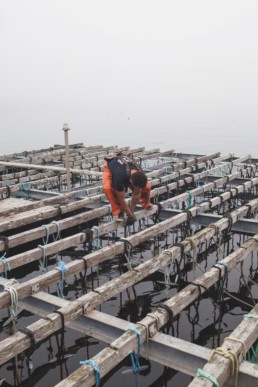
Lewis said DMR sends biologists to each site, maps the bottom, makes an underwater video, and then holds a public hearing. “We have ten decision criteria that must be met.”
Sebastian Belle, head of the Maine Aquaculture Association, said his group began training commercial fishermen to raise cod, but admits it turned out to be the wrong species.
The training continues but now is more broadly focused. The coursework is 16 to 20 weeks long, one day a week, Belle said. “We start with the biology of the animals they will farm, get into science and environmental monitoring and marketing, business management, gear . . . It’s comprehensive, but quick.”
The goal is to integrate fishing and farming. “If new farmers are also fishermen, it contributes to healthy communities and healthy working waterfronts,” said Morse of Maine Sea Grant.
Belle echoed that view.
“My beginning was commercial fishing, then aquaculture. It’s completely and utterly natural for preserving working waterfronts,” he said. “It’s a good way to diversify the economic base of fishing families.”
Some farmers are experimenting with other species, such as Arctic surf clams, razor clams, and sea scallops, said Morse. “I’m optimistic generally. It’s a good thing; it can go a long way,” he said.

